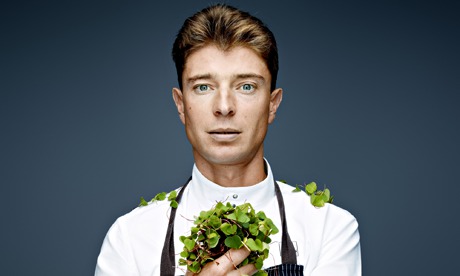
Much as trees, good restaurants become increasingly scarce the higher you climb. At 2,300 metres Val Thorens in the French Alps is surrounded by snow-clad slopes, overlooking the Three Valleys. With its Modernist design, you might think it only caters for hard-line skiers, but it also has a place for foodies. Chef Jean Sulpice, 35, has chosen to explore other peaks, making his brainchild the highest Michelin-starred restaurant in Europe.
It is nearly 11am on a February morning and already 40cm of snow has fallen. Indeed by early afternoon the road down to Moûtiers will be closed. But Sulpice's youthful team are very busy. First they must make lunch – fera [a popular local fish] tempura – for the staff, then for the village nursery – baby pancakes with chorizo and tarragon – one of their daily assignments. Only then will they turn their attention to the restaurant's customers who tramp in from the ski runs, their appetite whetted by the blizzard.
Sulpice could have opted for a less isolated location, like his stablemate Emmanuel Renault, who heads the three-star Flocons de Sel in Megève. But in 2002, aged only 24, he accepted the challenge posed by L'Oxalys, a hotel-residence looking for someone to turn its restaurant into a gourmet eatery. "I wanted a place that suited my character, and I was attracted by the young, sporting image of Val Thorens," he says.
For a chef there are other constraints apart from being geographically remote and at the mercy of the elements. Even the physical conditions are different: water, for instance, boils at 90C, wines mature more quickly and the air is so dry bread soon turns to rusk. And many of the resort's regulars are more interested in a hearty raclette than airy espumas.
In the early days Sulpice had to adapt, serving a skier's platter, similar to more humble establishments. But on the platter itself – custom designed by a local cabinet-maker – the chef served a squash velouté topped with Reblochon cappuccino, pot-au-feu made with foie gras, and a chocolate and Chartreuse granita.
Sulpice grew up in Aix-les-Bains, on the shore of Lac du Bourget. He struggled at school but at the age of 15 discovered that there could be scope for self-expression in cooking. At about the same time his elder brother, a cycling champion, had a serious accident and lost the use of both legs. For his sibling it was a lesson in persistence.
Happier staring at a plate than a blank page, the erstwhile dunce went to study under Marc Veyrat. In the mid-1990s the chef with the emblematic black hat was a local guru, raving about mountain herbs and reinventing Savoy cuisine. "Veyrat taught me that cooking is a form of storytelling," Sulpice explains. "He showed me you could find inspiration in childhood memories and the mountains."
As with any disciple, the young man took time breaking free from his master's influence. Indeed, reading between the lines of his menus, it is still apparent. Take the childhood theme, for instance: one of Sulpice's signature dishes is based on bread, parmesan and chestnuts. A smooth, boiling hot chestnut velouté contrasts with the airy bite of chill parmesan mousse. A pinch of grated truffle adds an earthy note and chestnut-bread croutons crunch.
As for the mountains his cooking is a constant reminder of the setting, but also completely transcends it. Much of what he serves is locally sourced, thanks to a network of local producers. For example he mixes a beaufort cheese mousse with heaps of herbs – willowherb, campion, pimpernel and lovage, among others – a bit like rolling a snowball in spring shoots. He makes liberal use of local fish too, often caught by Eric Jacquier, a champion angler on Lake Geneva. So you may choose from omble chevalier (a local variety of char) with Alpine pansies, fillet of perch with pistachio puree and a ginger and lemongrass sauce, or smoked fera with quail's eggs playing on the acidity of oxalis shoots (similar to sorrel) and cucumber water conjuring up the limpid waters of a lake.
Sulpice aims to keep things fairly simple ... within reason. His cooking is inspired by his surroundings but also the foreign countries he and his wife visit when the restaurant closes for a break in the spring. The contemporary design of the dining room itself is uncluttered and there are no tablecloths. The richness is in the dishes: a creamy, celeriac risotto with vin jaune and melted comté cheese; pigeon cooked in a salt crust flavoured with camomile; pike mousse with coffee sauce and pickled lemon; fera, sorrel and vanilla – all with lots of colourful, inventive touches.
The World Ski Awards 2013 named Val Thorens "world's best ski resort" and Sulpice's Michelin two-star restaurant no longer applies skier's platter prices: the menus range from €74 ($103) to €159. Diners can accompany their meal with Savoy wines, selected by Jean's wife Magali and her sommelière, Lorianne Brun, whose range includes a new generation of winegrowers (Berlioz, Magnin, Grisard, Quenard and Omont, among others) overturning stereotypes with just as much energy as the chef.
This article appeared in Guardian Weekly, which incorporates material from Le Monde

